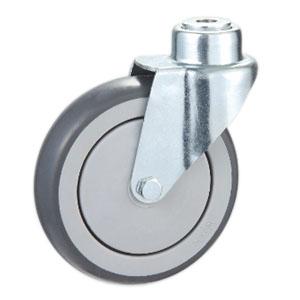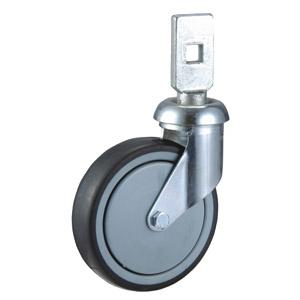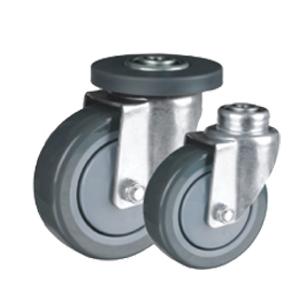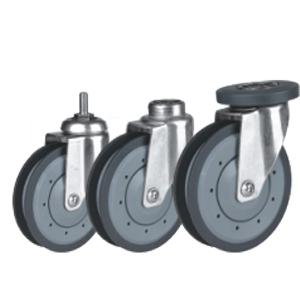Shopping Cart Caster Problems And How To Fix Them
The experience with a shopping cart must be seamless, and customers should not have to feel inconvenienced by their experiences with the shopping trolley caster wheels. The key to a perfect shopping cart? The shopping cart casters. Choose the right caster for your trolley, and you will be sure to provide your customers with the most seamless experience.
The shopping carts people find in a grocery store can define their entire grocery shopping experience. In fact, people often select the stores and markets they want to hit based entirely on the quality of the shopping carts there!
Common Problems With Shopping Cart Casters And How To Fix Them
Let's take a look at some of the most common issues that can wear down supermarket cart casters and how to prevent and fix these issues:
Overloading
Customers will usually keep loading a cart till it's full. Many workers also load shopping carts with heavy objects when transporting them.
Now, this practice is alright if the items they are loading the shopping cart with are light. However, if they load the trolley with heavy objects like large bottles of liquids, multiple cartons of soda or drinks, and other heavy objects, the cart will have difficulty moving. The shopping trolley wheels will suffer from the impact of the load and begin to wear down the longer they have to move under these conditions.
When customers want to buy a large number of items, the representatives in the store need to let them know they should use a second trolley for the other objects. The workers in the store should also be trained to avoid overloading the trolleys to keep the casters well-maintained.
Wrong Bearings
Bearings in the casters help reduce friction in the wheels' movement and allow for controlled movement of the cart. When picking the bearings for a cart, many people might be less vigilant and pick out the wrong kind of bearing. When this happens, the casters will fail quickly, and the shopping carts in the store will be a pain to use.
Make sure you pick the right bearings for your shopping cart casters from the get-go. In case your wheels have begun failing already, make sure you pick the correct bearings next time.
Bad Floors
The floor of the store needs to be in pristine condition to ensure that the trolleys work well. If the floor is rugged, the cart will undergo some shock every time it is moved, and this will cause the wheels to fail quickly. This also happens when customers and workers roll the cart on rough surfaces outside the store and keep them moving for a long time. Shopping cart casters generally do not have a lot of shock absorption properties since they have to be faster, so constant dragging on rough surfaces will easily damage the wheels.
Make sure the floors at the store are well-maintained and ensure that customers and workers don't take the cart outside store premises for too long. This way, you can lengthen the life of the wheels.
Tugging Wheels
When the supermarket cart wheels have been used for a long time, they begin to tug. The movement is not as smooth as it used to be, and customers no longer have that smooth shopping experience that they are looking for.
If the wheels of the cart begin to tug, make sure you lubricate them. This will help to clear any friction between the caster and its parts and allow for smooth rolling of the wheels again.
Wrong Caster Type
One of the main issues when selecting casters for your shopping cart is that you might select the wrong one without realizing it. This usually happens because people don't pay a lot of attention to small details such as caster wheels. However, caster wheels are some of the most important aspects of a shopping cart and need a lot of thought before you finally pick one.
Make sure you talk in detail with your caster vendor about the shopping cart caster that you want to select. Let them know exactly what you are looking for in a wheel so that they offer you the best option. If possible, test the wheel out first before you move forward with the process.


Excessive Swiveling
Sometimes, a shopping cart may begin to swivel more than is necessary when people are trying to move it. It often begins to turn as well when people want it to move in a single direction. This happens when the distance between the axle of the wheel and the rivet is too large. It often comes off as a design flaw and may affect one or two of the carts instead of all the carts in a batch.
When you test the caster wheel yourself before settling on it, you can ensure that the swivel offset is not a huge concern for you. Pick a manufacturer who knows how to design the perfect caster wheel and stick to them. If you find this problem in a wheel or two, you should have them replaced immediately.
Brinelling
Brinelling refers to dents on the caster that result from constant use of the wheel. If the brinelling is not corrected immediately, it also results in a large swivel offset when moving the cart. It also becomes difficult to move the cart in a straight line when there are too many dents on the wheel cap.
If brinelling has worn the caster wheel too much, you should have it replaced immediately to avoid displeasing your customers.
Rivet Failures
Most carts use a rivet or a kingpin to be held together for movement. When there is a load on the card, the rivet is where all the pressure is concentrated. Large loads and drop-impacts on a shopping cart can result in a rivet failure and prevent the cart from functioning properly.
To avoid this situation, you can use kingpinless shopping cart casters for the trolleys. These casters distribute the pressure from the load all over the wheel instead of concentrating it in one spot. Other than that, you can avoid dropping large loads on the trolleys to prevent the kingpin from wearing down as well.



 English
English Spanish
Spanish German
German Russian
Russian Arabic
Arabic Portuguese
Portuguese Italian
Italian French
French Hebrew
Hebrew Turkish
Turkish